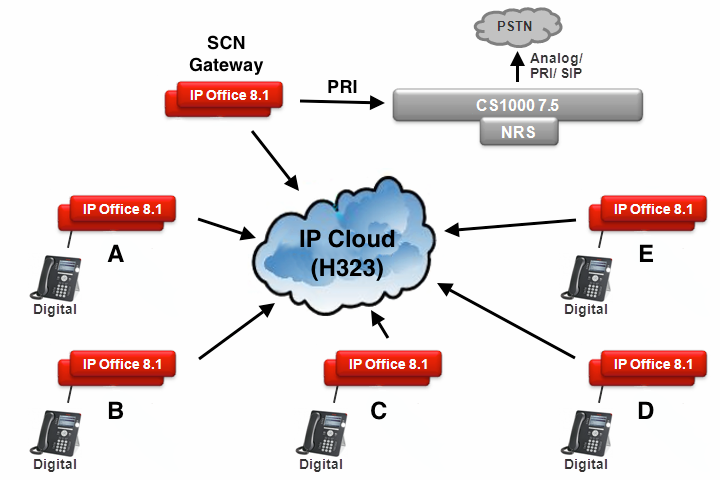This tutorial explains how to configure an SCN, and the ability to dial from a remote site, across an SCN network, to the main site’s trunks. The tutorial is divided into two sections, the first of which explains the configuration of Site A (the main site where the external trunks reside), and the second of which explains the configuration of site B (the remote site which needs to dial across the SCN, in order to utilize Site A’s trunks).
Site A:
- Address scheme:
- IP Office LAN 1: 192.168.42.1
- Subnet Mask: 255.255.255.0
- Default Gateway: 192.168.42.200
- Licenses/Hardware:
- Confirm a valid Voice Networking license is installed.
- Confirm a VCM or Combo card is installed.
- Create a new H.323 Line:
- VoIP Settings
- Gateway IP Address: 192.168.43.1 (Site B IP Office address)
- Supplementary Services: IP Office SCN
- VoIP Settings
- Short Codes (sub-tab of H.323 line – this code is used for inbound matching – this tells the system how to handle calls when the digits 9N are matched, coming from site B)
- Code: 9N
- Feature: Dial
- Telephone: N
- LGID: 50:Main (local ARS table where external calls are routed)
- Create a new IP Route:
- This is a default route that will route traffic from any IP address/mask via LAN1. In cases where more granular routing is required, this route may need to be changed, but this works for most deployments:
- IP Address: 0.0.0.0
- Subnet Mask: 0.0.0.0
- Gateway IP Address: 192.168.42.200 (local gateway on this network)
- Destination: LAN1
- This is a default route that will route traffic from any IP address/mask via LAN1. In cases where more granular routing is required, this route may need to be changed, but this works for most deployments:
Site B:
- Address scheme:
- IP Office LAN 1: 192.168.43.1
- Subnet Mask: 255.255.255.0
- Default Gateway: 192.168.43.200
- Licenses/Hardware:
- Confirm a valid Voice Networking license is installed.
- Confirm a VCM or Combo card is installed.
- Create a new H.323 Line:
- VoIP Settings
- Gateway IP Address: 192.168.42.1 (Site A IP Office address)
- Supplementary Services: IP Office SCN
- VoIP Settings
- VoIP line
- Outgoing Group ID: 1
- IP Route:
- IP Address: 0.0.0.0
- Subnet Mask: 0.0.0.0
- Gateway IP Address: 192.168.43.200 (local gateway on this network)
- ARS Table:
- Edit the existing ARS codes (in this example the 1N code is used, but the same must be done for all of the other ARS codes as well):
- Code: 1N
- Feature: Dial
- Telephone: 9N (send an extra 9 to trigger outbound dialing rules when the call is received by Site A)
- LGID: 1 (the LGID of the local H.323 line)
- Edit the existing ARS codes (in this example the 1N code is used, but the same must be done for all of the other ARS codes as well):
- An ARS table with all of the codes changed is displayed below. Please note that dial emergency codes are not configured in this example, but it is always a good idea to have a local trunking solution for emergency calls.
Troubleshooting:
You should now be able to make calls from Site B, out of site A’s trunks. If you are unable to make calls, here are some troubleshooting steps:
- Do other SCN functions work? Can you make extension to extension calls across the SCN?
- Look in System Status to confirm that the correct ARS pattern is being used and that calls are trying to go across the LGID of the H.323 line.
- Open up Monitor
- Turn on default + H.323 filters.
- Place a call from Site B to Site A.
- Check to see which short codes and ARS table are matched.
- Confirm that the full number, including the dialing access code (9 in most cases) are sent in the H.323 packet to Site A.
Discover more from IP Office Assistance
Subscribe to get the latest posts sent to your email.

